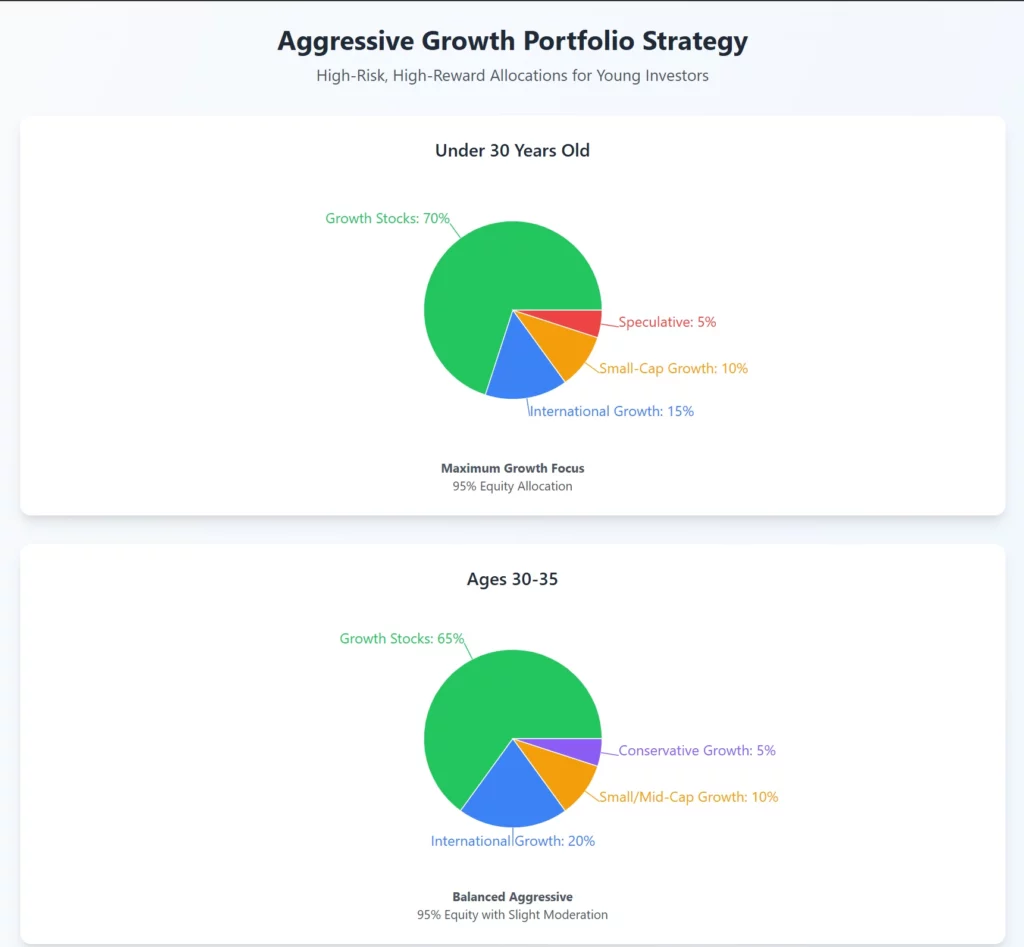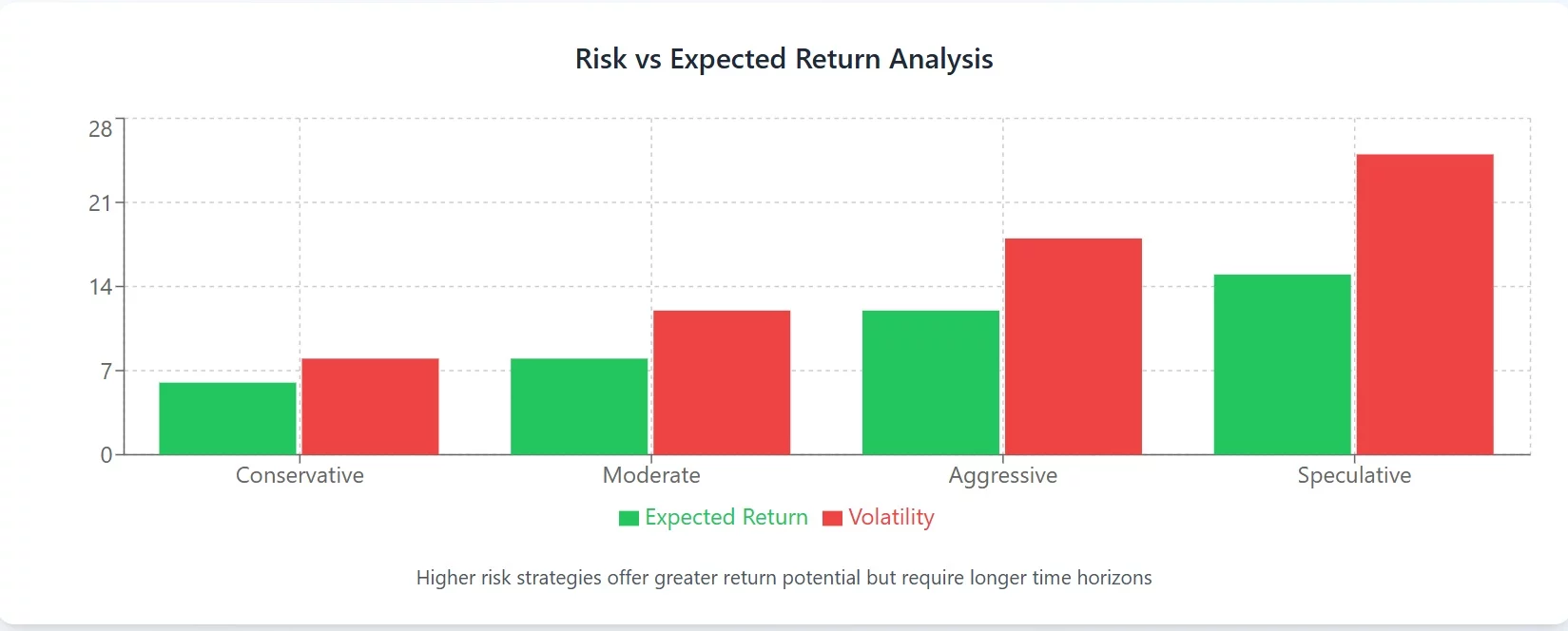I began trading in 2015 and started coaching in 2019. Young investors possess the greatest advantage in building wealth: time. However, most waste this opportunity on conservative strategies that limit growth potential. Therefore, this guide reveals aggressive portfolio strategies designed specifically for high-risk tolerance investors.
👉 In this guide, you will learn:
- 🚀 Why aggressive portfolios make sense for investors under 35
- 📊 High-growth asset allocation strategies that maximize returns
- 💰 Risk management techniques for volatile investments
- 🎯 Sector rotation strategies for growth maximization
- 📈 Advanced portfolio construction for aggressive investors
- ⚡ Technology and growth stock selection criteria
- 🔄 Rebalancing strategies for high-volatility portfolios
Young investors often follow conservative advice meant for older generations. Unfortunately, this approach sacrifices decades of compound growth potential. Additionally, playing it safe when young actually increases long-term financial risk.
Table of Contents
The Young Investor’s Growth Advantage 🎯
Young investors between ages 20-35 can pursue strategies that older investors simply cannot risk. Furthermore, time horizon advantages enable recovery from market downturns that would devastate near-retirees. Therefore, aggressive growth strategies become logical rather than reckless.
Why aggressive strategies work for young investors:
- ⏰ 30-40 years until retirement allows full market cycle recovery
- 💵 Lower current expenses enable higher risk tolerance
- 📈 Decades of compound growth multiply aggressive returns
- 🔄 Multiple opportunities to adjust strategy over time
- 💪 Earning potential can offset temporary investment losses
However, aggressive investing requires understanding the difference between intelligent risk-taking and gambling. Moreover, systematic approaches prevent emotional decision-making during volatility.
Key principles for aggressive young investors:
- 🎯 High conviction investments rather than speculation
- 📊 Diversification within high-growth sectors
- 🧠 Education-driven decisions over social media tips
- ⚖️ Risk management even with aggressive allocation
- 🔄 Regular portfolio monitoring and adjustment
Building Your Aggressive Growth Portfolio 🚀
Aggressive portfolios require strategic construction rather than random stock picking. Furthermore, concentration in growth sectors provides better risk-adjusted returns than individual speculation. Additionally, systematic approaches prevent costly emotional decisions.
Core Growth Allocation Strategy
Recommended aggressive allocation for investors under 30:
- 📊 70% Growth stocks (technology, biotech, emerging industries)
- 📊 15% International growth markets (emerging markets, innovative economies)
- 📊 10% Small-cap growth funds
- 📊 5% Speculative investments (individual growth stocks, sector ETFs)
Recommended aggressive allocation for investors 30-35:
- 📊 65% Growth stocks and growth-focused funds
- 📊 20% International diversification including growth markets
- 📊 10% Small-cap and mid-cap growth exposure
- 📊 5% Conservative growth (dividend growth stocks)

High-Growth Sector Focus
Technology and innovation sectors drive most aggressive portfolio returns. However, sector concentration requires understanding cyclical patterns and rotation strategies. Moreover, diversification within growth sectors reduces single-stock risk.
Primary growth sectors for aggressive portfolios:
- 💻 Technology: Cloud computing, artificial intelligence, cybersecurity
- 🧬 Biotechnology: Gene therapy, precision medicine, pharmaceutical innovation
- 🔋 Clean energy: Solar, wind, battery technology, electric vehicles
- 🏠 Real estate technology: PropTech, REITs in growth markets
- 💰 Financial technology: Digital payments, cryptocurrency infrastructure
Sector allocation strategies:
- 🎯 Maximum 25% in any single sector to maintain diversification
- 🔄 Rotate between sectors based on market cycles and valuations
- 📊 Use sector ETFs for broad exposure before individual stock selection
- 📈 Monitor sector momentum and trend reversals regularly
Risk Management for Aggressive Investors ⚖️
Aggressive investing does not mean abandoning risk management entirely. Instead, it requires different approaches suited to volatile portfolios. Furthermore, proper risk management enables sustainable aggressive strategies over decades.
Position Sizing and Concentration
Large positions in high-conviction investments can drive superior returns. However, concentration risk can also destroy portfolios during sector downturns. Therefore, strategic position sizing balances growth potential with survival probability.
Position sizing guidelines for aggressive portfolios:
- 🎯 Maximum 5% in any individual stock initially
- 📈 Allow winners to grow to 8-10% through appreciation
- 📉 Trim positions exceeding 10% and redistribute
- 🔄 Maintain at least 20 different positions for base diversification
Volatility Management Techniques
Aggressive portfolios experience significant volatility that can trigger emotional selling. Therefore, volatility management techniques help maintain long-term strategy during turbulent periods. Additionally, systematic approaches prevent panic decisions.
Volatility management strategies:
- 📊 Dollar-cost averaging into positions over 3-6 months
- 🔄 Regular rebalancing to maintain target allocation
- 💰 Cash reserves for opportunistic buying during downturns
- 📈 Stop-loss orders only for speculative positions
- 🧠 Pre-planned response strategies for major market declines
Emergency Fund Considerations
Aggressive investors still need emergency funds despite higher risk tolerance. However, opportunity cost considerations may justify smaller emergency fund allocations. Moreover, liquid aggressive investments can provide partial emergency coverage.
Emergency fund strategies for aggressive investors:
- 💰 3-month expenses minimum in high-yield savings
- 📊 Additional 3-month coverage in conservative investments
- 🏦 Credit access through lines of credit for extreme emergencies
- 🔄 Avoid selling aggressive investments for non-emergency needs
Advanced Portfolio Construction Strategies 📈
Sophisticated portfolio construction techniques can enhance returns while managing risk. Furthermore, young investors have time to learn and implement advanced strategies. Additionally, technology tools democratize professional-grade portfolio management.
Growth Stock Selection Criteria
Successful aggressive investing requires systematic stock selection rather than random picking. Moreover, fundamental analysis becomes crucial for identifying sustainable growth companies. Therefore, established criteria prevent speculation disguised as investing.
Key growth stock evaluation factors:
- 📊 Revenue growth exceeding 20% annually for multiple years
- 💰 Expanding profit margins indicating operational efficiency
- 🎯 Large addressable markets with significant growth potential
- 💡 Competitive advantages protecting market position
- 💪 Strong management teams with execution track records
- 📈 Reasonable valuations relative to growth prospects
Momentum and Trend Following
Growth stocks often exhibit momentum that can be systematically captured. Furthermore, trend-following strategies can enhance returns during bull markets. However, momentum strategies require discipline during trend reversals.
Momentum strategy implementation:
- 📈 Buy stocks breaking out to new 52-week highs with volume
- 🔄 Add to positions showing continued relative strength
- 📉 Reduce positions falling below key moving averages
- 📊 Monitor sector rotation and shift allocations accordingly
- ⏰ Use 3-6 month holding periods for momentum trades
International Growth Opportunities
Global markets provide growth opportunities unavailable in domestic markets. Furthermore, emerging markets often deliver superior growth rates despite higher volatility. Additionally, international diversification reduces dependence on single-country performance.
International growth allocation strategies:
- 🌍 25-30% total portfolio allocation to international markets
- 📊 60% developed international markets (Europe, Japan, Australia)
- 📊 40% emerging markets (China, India, Southeast Asia, Latin America)
- 🎯 Focus on countries with growing middle classes and technology adoption
- 💰 Use international growth funds for broad exposure initially
Technology-Driven Investment Strategies 💻
Technology revolutionizes both investment opportunities and portfolio management tools. Furthermore, young investors can leverage technology for competitive advantages. Additionally, understanding technology trends enables better investment selection.
Robo-Advisors for Aggressive Portfolios
Most robo-advisors offer conservative allocations unsuitable for aggressive investors. However, some platforms provide aggressive options with sophisticated rebalancing. Moreover, hybrid approaches combine human guidance with automated execution.
Robo-advisor features for aggressive investors:
- 🤖 Aggressive allocation options with 90%+ equity exposure
- 🔄 Automatic rebalancing with tax-loss harvesting
- 📊 Goal-based investing for multiple time horizons
- 📱 Mobile apps for easy monitoring and adjustments
- 💰 Low fees that don’t erode aggressive returns
Portfolio Tracking and Analytics
Advanced portfolio tracking enables better decision-making and performance optimization. Furthermore, analytics tools identify weaknesses and improvement opportunities. Additionally, systematic tracking prevents emotional bias in performance evaluation.
Essential portfolio tracking metrics:
- 📊 Total return versus relevant benchmarks
- 📈 Sector allocation drift from target percentages
- 💰 Risk-adjusted returns (Sharpe ratio, maximum drawdown)
- 🔄 Rebalancing frequency and transaction costs
- 📉 Individual position performance and contribution
Cryptocurrency Integration Strategies
Cryptocurrency represents the ultimate aggressive investment for young portfolios. However, crypto requires careful integration rather than speculation. Moreover, systematic approaches prevent crypto volatility from destroying overall portfolio performance.
Strategic cryptocurrency allocation:
- 🪙 Maximum 5-15% of aggressive portfolio in cryptocurrency
- 📊 Focus on established cryptocurrencies (Bitcoin, Ethereum)
- 🔄 Dollar-cost average into positions over time
- 💰 Treat as speculative allocation requiring total loss tolerance
- 📈 Rebalance regularly to prevent overallocation during bull runs
Sector Rotation and Market Timing Strategies 🔄
While market timing generally fails, sector rotation can enhance aggressive portfolio returns. Furthermore, understanding economic cycles enables strategic sector allocation. Additionally, young investors have time to learn and refine timing techniques.
Economic Cycle-Based Rotation
Different sectors outperform during various economic phases. Moreover, systematic rotation based on economic indicators can improve returns. However, rotation strategies require discipline and systematic implementation.
Economic cycle sector rotation:
- 📈 Early cycle: Technology, consumer discretionary, financials
- 📊 Mid cycle: Industrials, materials, energy
- 📉 Late cycle: Consumer staples, utilities, healthcare
- 🔄 Recession: Bonds, defensive stocks, value opportunities
Growth Style Rotation
Growth investing styles cycle between momentum, quality, and value-oriented approaches. Furthermore, recognizing style cycles enables allocation adjustments. Additionally, diversification across growth styles reduces style-specific risk.
Growth style categories:
- ⚡ Momentum growth: Recent price and earnings acceleration
- 💎 Quality growth: Consistent earnings growth with strong fundamentals
- 💰 Value growth: Growth companies trading at reasonable valuations
- 🚀 Speculative growth: Early-stage companies with massive potential
Common Aggressive Investing Mistakes 🚨
Understanding typical mistakes helps young investors avoid costly errors. Furthermore, aggressive strategies amplify both gains and losses from poor decisions. Therefore, mistake awareness becomes crucial for long-term success.
Overconcentration in Single Stocks
Young investors often put too much money in individual stocks they research heavily. However, even great companies can decline due to factors beyond analysis. Moreover, diversification remains essential even in aggressive portfolios.
Concentration risk management:
- 🎯 Limit individual positions to maximum 5% initially
- 📈 Trim positions that grow beyond 10% of portfolio
- 🔄 Reinvest trimmed gains into new opportunities
- 📊 Maintain minimum 20 different positions
Emotional Trading During Volatility
Aggressive portfolios experience dramatic swings that trigger emotional responses. Furthermore, buying high and selling low destroys long-term wealth building. Therefore, systematic approaches prevent emotion-driven decisions.
Emotional trading prevention:
- 📋 Written investment plan with specific criteria
- 🔄 Automatic investment schedules during volatility
- 💰 Pre-planned responses to major market declines
- 📊 Focus on long-term goals rather than daily performance
Chasing Performance and Hot Sectors
Recent outperformers often become tomorrow’s underperformers. Moreover, chasing performance typically results in buying high and selling low. Additionally, hot sector rotation usually reverses when least expected.
Performance chasing prevention:
- 📊 Stick to systematic allocation regardless of recent performance
- 🔄 Rebalance regularly back to target weights
- 📈 Dollar-cost average into underperforming positions
- 🎯 Focus on fundamental analysis over recent price action
FAQs 🤔
Q: How aggressive should my portfolio be in my 20s? A: Investors under 30 can typically handle 90-100% stock allocation with focus on growth sectors. However, adjust based on personal risk tolerance and financial stability.
Q: Should I use individual stocks or funds for aggressive growth? A: Start with growth-focused ETFs and Index funds for diversification, then gradually add individual stocks as knowledge and confidence increase.
Q: How do I handle the volatility of aggressive portfolios? A: Focus on long-term goals, maintain emergency funds, and avoid checking portfolio performance daily. Systematic rebalancing helps manage volatility constructively.
Q: What’s the difference between aggressive investing and gambling? A: Aggressive investing uses systematic approaches, diversification, and fundamental analysis. Gambling relies on speculation, tips, and emotional decisions.
Q: How much should I allocate to cryptocurrency in an aggressive portfolio? A: Limit cryptocurrency to maximum 5-15% of total portfolio. Treat it as speculative allocation requiring complete loss tolerance.
Q: When should I start reducing portfolio aggressiveness? A: Gradually reduce aggressiveness starting around age 35-40, depending on wealth accumulation and retirement timeline goals.
Q: How often should I rebalance an aggressive portfolio? A: Rebalance quarterly or when any position moves more than 5% from target allocation. Aggressive portfolios require more frequent monitoring.
Q: Should I attempt to time the market with aggressive strategies? A: Avoid market timing. Instead, use systematic approaches like dollar-cost averaging and sector rotation based on fundamentals rather than predictions.
Conclusion
Aggressive growth portfolios enable young investors to maximize their time advantage for wealth building. Therefore, strategic approaches that balance growth potential with risk management become essential. Furthermore, systematic implementation prevents emotional decisions that derail long-term success.
Smart young investors understand that conservative strategies early in careers actually increase long-term financial risk. Additionally, aggressive approaches require education, discipline, and systematic execution rather than speculation.
Finally, remember that aggressive investing means taking calculated risks with systematic approaches rather than gambling with retirement security. The goal remains long-term wealth building through superior returns while managing downside risk appropriately.

Hold a Master Degree in Electrical engineering from Texas A&M University.
African born – French Raised and US matured who speak 5 languages.
Active Stock Options Trader and Coach since 2014.
Most Swing Trade weekly Options and Specialize in 10-Baggers !
YouTube Channel: https://www.youtube.com/c/SuccessfulTradings
Other Website: https://237answersblog.com/
